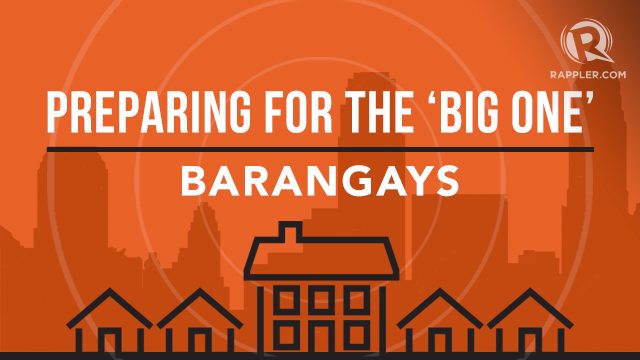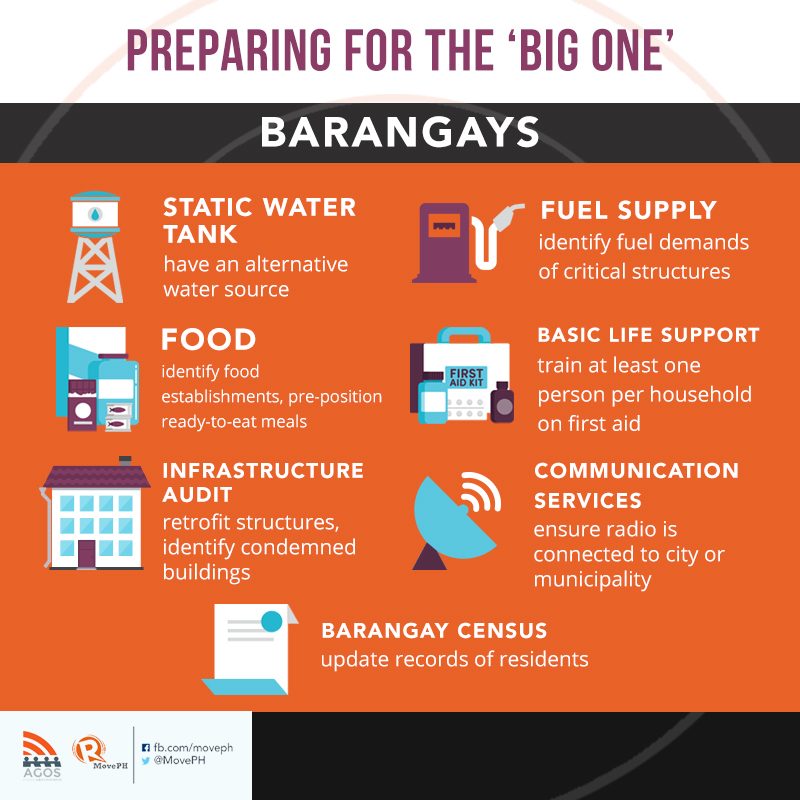SUMMARY
This is AI generated summarization, which may have errors. For context, always refer to the full article.

CHECKLIST: What should households prepare for an earthquake
CHECKLIST: What should barangays prepare for an earthquake
MANILA, Philippines – If a 7.2-magnitude earthquake hits your local community, is it ready for the worst-case scenario? (READ: How to prepare when disaster and emergency strike)
Once the West Valley Fault moves, various areas in Metro Manila and nearby provinces are expected to be greatly damaged. The fault moves roughly every 400 years, according to Philippine Institute of Volcanology and Seismology (Phivolcs) Director Renato Solidum. In the last 1,400 years, it has moved only 4 times. (READ: What dangers await when the West Valley Fault moves?)
If this devastating earthquake does happen, Metro Manila could run out of food and water for a week. It could also destroy 40% of buildings, trigger fire in various parts of the city and kill around 35,000 to 40,000 people. Experts say that the “Big One” could happen in this lifetime. (READ: Date of #MMShakeDrill 2018 will not be announced – MMDA)
Role of LGUs, local councils during disasters
As indicated in the 1991 Local Government Code, local government units should be at the frontline of emergency measures in the aftermath of disasters. Local officials must lead the delivery of services related to their line of work, particularly during, and in the aftermath of, man-made disasters and natural calamities.
Here is a list of earthquake preparedness measures provided by the Department of the Interior and local Government (DILG)-National Capital Region for barangays:

- PREPARE A STATIC WATER TANK
Each barangay should get at least one static water tank to serve as an alternative water source.
- IDENTIFY A FOOD WAREHOUSE
Identify all critical food related establishments in the barangay and enter into a MOA to secure food supply. Moreover, position in advance DOST’s ready-to-eat meals in identified evacuation areas and open spaces.
- AUDIT AND RETROFIT INFRASTRUCTURE
Recommend all infrastructure which shall be prioritized for retrofitting and those that may already be condemned. Also, map out all critical roads and structures for necessary action.
- CHECK FUEL SUPPLY
Identify critical infrastructure that will greatly need fuel supply, especially their locations and projected fuel demands.
- CONDUCT TRAINING FOR BASIC LIFE SUPPORT
Conduct training for at least one family member per household on Basic Life Support – First Aid (BLSFA) and other lifesaving skills to supplement medical first responders.
- ENSURE RADIO COMMUNICATION SERVICE
Ensure that the UHF/VHF radio is connected to the city or municipality.
- UPDATE BARANGAY CENSUS
Update the registry of barangay inhabitants to allow easier accounting of survivors.
While earthquakes cannot really be predicted, barangays can still reduce the risks and possible damages by proper planning and careful preparation.
How are your local communities preparing for a major disaster? Let us know in the comments or write your thoughts on X. – with reports from Kaye Cabal/Rappler.com
Add a comment
How does this make you feel?





There are no comments yet. Add your comment to start the conversation.